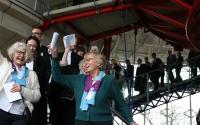29 February 2008The New York Times
The fortunes of this little village have long depended on the fortunes of Heathrow Airport, just a couple of miles away. But just as it has lived for Heathrow, Sipson might have to die for Heathrow.
If the government goes ahead with its plans to build a third runway for the overstuffed airport, the village will be wiped from the map. The 700 or so houses, the elementary school, the church, the pubs, the Indian restaurant, the hair salon — all those would be torn down.
Naturally, Sipson, dotted as it is with “No Third Runway” signs, opposes the plans. But the village, already weakened by the exodus of longtime residents worried about the future, has become the symbol of an anti-expansion campaign that goes far beyond its borders.
Angry at what they say is government hypocrisy about climate change, groups like Greenpeace and Friends of the Earth are framing the fight over the third runway as a critical test of global efforts to stem the trend toward ever bigger airports and ever more flights.
“Britain is really a very important country when it comes to creating a culture around aviation — we have a binge attitude toward aviation here,” said Ben Stewart, a spokesman for Greenpeace U.K. “We also have a more sophisticated climate-aviation debate here, and we think if we can win it here it will make a difference in other countries.”
Greenpeace drove home its point this week when four members sneaked into Heathrow, climbed onto a parked airplane and affixed an anti-third-runway banner to its tail. They were immediately arrested, as were five protesters from the Plane Stupid group who climbed onto the roof of Parliament on Wednesday and unfurled their own banners.
“We want to highlight the inherent contradictions between having a supposedly progressive climate change program on the one hand, and on the other hand pushing forward plans to lock Britain into high emissions for decades to come,” Mr. Stewart said.
Prime Minister Gordon Brown’s Labor government has pledged to cut Britain’s carbon emissions from 1990 levels by 26 percent to 32 percent by 2020, and by at least 60 percent — and possibly as much as 80 percent — by 2050.
As part of the plan, the government says, airlines exceeding the limits would be required to offset their emissions by paying for equivalent reductions elsewhere.
Opponents say that the government assumptions are ridiculous. “The government has said that air pollution levels will be lower than they are today and that noise levels will not get any higher because planes and cars will get significantly quieter and cleaner,” said John Stewart, chairman of the Heathrow Association for the Control of Aircraft Noise. “I would love to live in such a green age where cars and planes are going to get so clean so quickly.”
Few would argue that Heathrow, one of the busiest passenger airports in the world, is also among the most reviled. Unfriendly, overcrowded and puzzlingly vulnerable to crippling meltdowns at crucial travel times, Heathrow is regularly cited by travelers as one of the worst things about coming to London.
The answer, according to a coalition encompassing the government, business leaders and BAA, the company that owns the airport, is to make it bigger. A fifth terminal, built over residents’ and environmentalists’ objections at a cost of nearly $9 billion, is to open next month.
At the same time, the government is proposing to increase the number of flights coming in and out of Heathrow, to about 700,000 a year from the current 480,000. This would be accomplished not only by building the new runway but also by making better use of the two existing runways, where flights are currently staggered to give people living in the flight paths a break from the noise.
“The government is committed to a third runway, providing strict environmental criteria can be met, and the government believes they can,” a spokesman for the Department for Transport said in an interview, speaking on condition of anonymity under government policy.
The plans are opposed not only by environmentalists and by Heathrow’s neighbors, but also by the four boroughs whose two million residents would be most affected by the noise, by the local members of Parliament, by all four candidates in the London mayoral race and by the opposition Conservative and Liberal Democrat parties.
The opponents were allowed to make their case during the government’s consultation period, which ended this week. But Nick Hurd, a Conservative member of Parliament whose district is in Heathrow’s flight path, said that it was unclear how hard the government — which is to make the final decision, possibly by the summer — would listen. When Terminal 5 was approved, he said, the authorities had falsely promised that there would be no need for a third runway.
“I detect a widespread disillusionment among constituents who feel it is a done deal,” Mr. Hurd said.
That is certainly the case in Sipson, where residents are living with a mixture of fatalism and fear. Jackie Clark, 36, a fourth-generation resident whose grandfather lived in Sipson when it was farmland, said the village and its strong sense of community had already been irreparably damaged.
Sipson is not under the airport flight path, so it is surprisingly quiet, almost cozy, for a place so close.
“You had everything here — an excellent school, excellent travel facilities — and people generally didn’t move away,” said Ms. Clark, who runs the local hair salon. “It’s only since the talk about the runway has come that people are panic-selling and moving.”
The houses have been bought by associations that have rented them to transients, introducing vandalism and petty crime to the village. Residents trade rumors about what kind of financial compensation they might or might not get if the government condemns the village. The older people hang on, hoping it will never happen.
“Everyone’s in limbo,” Ms. Clark said. Because she is living in a rented house and cannot afford to pay to move her business, she is, she said, considering moving to Canada.






